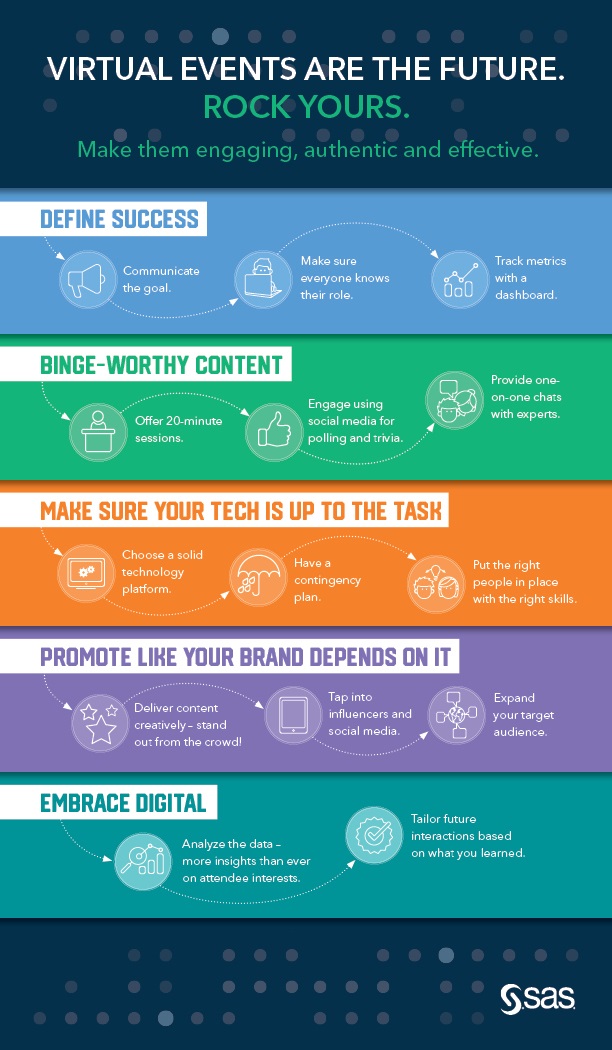Imagine driving in a foreign country at night with no GPS and half a tank of gas in the pouring rain. And you have to reach your destination before sunrise. That’s a little like how it felt when COVID-19 turned our 2020 plans upside down, and we raced into the unknown to transform SAS’ annual in-person flagship event into a virtual experience.
Since 1976, SAS® Global Forum has attracted thousands of SAS users, executives and academics from around the world. Originally scheduled for the end of March, this year’s event was packed with hundreds of workshops, presentations and demos on the latest advanced analytics and AI. But amid a global pandemic and a long overdue reckoning with social injustice in the US, we were forced to ask hard questions about relevancy, messaging and sensitivity. Most obviously, the company was in the precarious position of holding an in-person event that clearly couldn’t happen in person.
Fast forward a few months to June, and SAS Global Forum 2020 was a high point in the company’s history. We had 22,000 attendees – more than four times any previous year. A 50% increase in net new attendees for 2020. And not only did more people tune in, but they also stayed online longer – twice the industry average for similar virtual events. From the number of registrants to media awareness to pipeline revenue, the event succeeded by nearly every metric we outlined.
So how did SAS do it? Here are some things we learned along the way that we hope may help other organizations shifting to online experiences.
1. Have a goal and communicate benchmarks for success
We needed to understand the framework for how we were going to make decisions moving forward. And since we didn’t have a road map for 2020, we relied on our value system. We made decisions that we would be proud of 10 days, 10 months or 10 years from now.
There were lots of discussions about what exactly success would look like. Or whether it was even possible. To make sure the event was relevant, we postponed it until early June. One of the most important things that helped us be successful was providing clarity around what success would look like. So we set a goal of 20,000 registrations and made sure that all of us understood exactly what we were working toward.
To ensure that all the stakeholders were on the same page, we set up a dashboard powered by SAS® Viya® with up-to-date metrics on everything from audience profile to registration numbers and marketing effectiveness. This was our North Star throughout the process.
Democratizing analytics and making data insights accessible for all the stakeholders was critical in empowering our teams to make the best decisions as they all pulled toward the same goal.
2. Focus on the content
When you’re creating a virtual event, content isn’t just king – it’s the whole kingdom. Going from physical to digital requires a more compelling story, so it was important to create more engaging experiences. It’s easy to exit a digital event, so we had to tailor our story for a digital world.
For SAS Global Forum, this meant condensing breakout sessions to a bingeworthy 20 minutes, using social media for polling and trivia, and enabling attendees to chat one-on-one with subject matter experts. We made sure it wasn’t just a passive experience but a two-way conversation. Creating deliberate paths to continue the conversation past the day of the event is even more critical in a virtual world.
3. Make sure your tech – and the people behind it – are up to the task
The people who plan the logistics of a virtual event are not necessarily the same people who plan the logistics of a physical one. We had to rely on a whole different skill set.
SAS also spent time finding and developing a platform that not only helped us create interactive experiences but also ensured we could handle 20,000 people logging on at once. Still, it’s good to have a backup plan. Or six. In case our site was overwhelmed, we had another platform ready to go at the flick of a switch. And we were thrilled when we didn’t have to use it.
4. Promote like your brand depends on it
When the event parameters change, so does the promotion strategy. We made this a “whole marketing” effort and tapped into our global community, providing enablement materials that empowered our employees across the globe to promote within their own regions.
Removing geographic constraints helped us reach new relevant audiences globally. We used behavior-based segmentation models and lookalike targeting to discover new potential attendees with an interest in data, analytics and digital transformation. And we used external influencers with expertise in digital disruption and data science to promote the event to their audiences. By using new digital channels, we were able to better understand who was consuming the content and how to tailor it moving forward.
5. Report the results
There are certain advantages to going fully online. With everything being digital, SAS had more insights than ever about attendee behavior. Marketers could see where individuals went, what they viewed and what they were interested in – information that our sales team used to personalize interactions with customers and prospects.
We recently announced we will hold an additional event, SAS Executive Connection: Reimagine, on Nov. 10. This will be a virtual SAS event focused on how organizations can apply lessons from the global pandemic to prepare for the future. The knowledge we gained from SAS Global Forum has better prepared us to design and execute immersive, topical events for our audience.
Register for the executive connection | We hope to see you there

